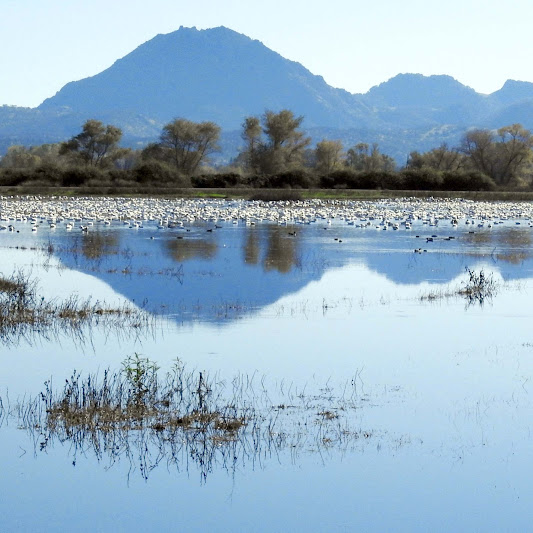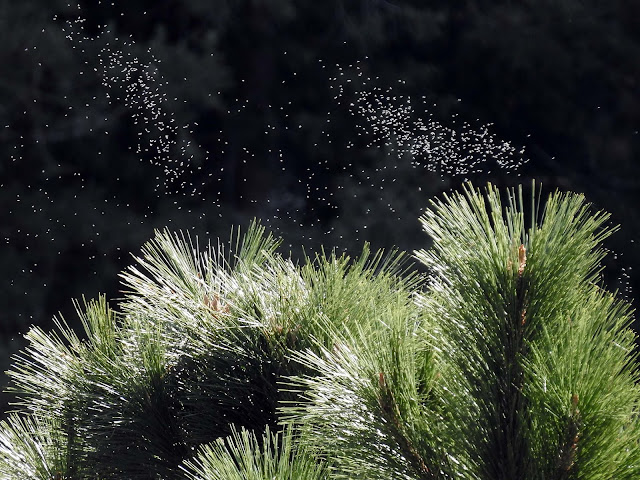Giant Chain Fern - Black Oak & Dendroalsia Moss
Woodwardia fimbriata - Quercus kelloggii - Dendroalsia albietina
On Thursday, a group of us hiked the Canyon Creek Trail, which follows the North Yuba River for approximately 3 miles to its junction with Canyon Creek. It's around 2500' in elevation, damp and moist at this time of year, and forested with Madrone, Big-leaf Maple, Tanoak, Black Oak, Incense Cedar, and Douglas Fir. Right now the trailside rocks are covered in lush Dendroalsia Moss, mushrooms have popped up everywhere, and Giant Chain Ferns are flourishing on the banks. The deciduous trees had created a carpet of colorful leaves on the forest floor which glowed in the late afternoon sun. It was gorgeous!

Orb Weaver Web & Tangle/Cobweb
As soon as we started our hike, spider webs caught our eye! They were incredibly bejeweled with dewdrops! Just gorgeous!!! Spider webs are pretty incredible structures. Spider silk is a protein fiber that varies in structure (up to 7 different kinds) depending on its use! Most silks have exceptional mechanical properties, including high tensile strength and extensibility. A given weight of silk is five times stronger than the same weight of steel! Some spiders repair their webs at night. Others eat their web and rebuild it daily! Some spiders, such as the Crab Spider, don't build webs at all and rely on camouflage and ambush to catch their prey!
The Orb Weaver web above was made by a female spider. The female spider doesn't get stuck in her own web because she mainly travels on the non-sticky structural lines. Sometimes she has to walk on the sticky spiral lines, but her hairy legs have an oil that keeps them from sticking! Male Orb Weavers don't make webs. They spend their time cruising for females to mate. At this time of year, the females are laying their last clutch of eggs, and will die at the first frost. The eggs will overwinter, up to several hundred eggs in one egg sac, and hatch in the spring.

Sheet Web
There were lots of these sheet webs in the dry grasses, often in clusters. There are over 4, 600 species of sheet web weavers in the world! They are very tiny and don't use sticky thread, but rather entangle and snare prey in their dense webs.
"There are five basic types of spiderwebs, each unique to a distinct species of spiders. The parts that make up a spider web can be summed up as such; two different types of silk, one being dragline silk which are the radial threads from the outer edges of the web to the center. Capture silk is the second, and these threads are what absorb momentum when prey collide with the web.
Spiral Orb webs are the most commonly known, made by orb weavers. These webs are made with two spirals, the first being a non-sticky basic web, the second covered in adhesive. Once the adhesive spiral is complete the spider removes the initial spiral. The appearance of these webs looks like a wheel with spokes.
Tangle/Cobwebs are typically associated with the Theridiidae family (black widows or house spiders, for example.) These webs lack symmetry and are simply several jumbled threads supported by a base.
Sheet webs are horizontally spun, flat sheets of silk between tufts of grass or tree branches. These webs are made with individual strands or are woven as a thick sheet of silk, and the spider will also spin separate criss-crossed threads about the sheet. Some of the spiders associated with this web type include the bowl and doily spider, and the filmy dome spider.
Funnel webs generally hidden between rocks, close clusters of vegetation, or any area that provides a decent amount of shelter. These non-sticky funnel-shaped webs are used as burrows for the spider, and are typically inhabited by multiple families (Agelenidae, Dipluridae and Hexathelidae) one example would be the hobo spider.
Tubular webs are similar to funnel webs in the way that they are typically found on the ground or along the bases of trees. These webs are just as they are named, tubes of web that are used as a hiding place until something triggers a thread radiating from it."

unknown mushroom - unknown mushroom - Questionable Stropharia
The spider webs were mainly out in the sunny areas. As soon as we were in the shady, damp forest we started to find lots of different mushrooms! Once again, none of us knew the names of most of them, but we enjoyed seeing them!
unknown mushroom - Turkey Tails - unknown mushroom
Convergent Ladybird Beetles - Hippodamia convergens
When we got the the end of the trail, there were thousands of Ladybird Beetles on the rocky point where the North Yuba River and Canyon Creek join together. Every fall I've hiked here, ladybugs have always been present! I always am so pleased whenever I see natural events reoccurring!
The word "bug" is commonly used as a name for any insect. However, Ladybugs are not true bugs, they're beetles! A more scientifically correct name for them is Ladybird Beetles. Every year 1,000's of these Ladybird Beetles converge to mate on this rocky, sunny, point. They remain here throughout the winter and return to lower elevations in the Spring, when temperatures warm up. Like most over-wintering insects, they replace any water in their body fluids (hemolymph) with an anti-freeze during the winter. This prevents any frost from forming within their cells and causing damage. There aren't many predators of ladybugs, as they secrete a noxious fluid that makes them unpalatable.
Sierra Newt - Taricha torosa
After spending some time at the confluence, we headed back to the trailhead. On the way, my friend Diane spotted some wonderful critters! First she saw two different California Newts crossing the trail! Apparently the warmer temperature made them become active! Their mating season should be over by now, so maybe they were out just looking for the perfect place to overwinter, usually under some forest duff or fallen log. Not many animals prey on newts, as they are poisonous. However, garter snakes are known to develop a tolerance to the newt's neurotoxin, tetrodotoxin! Handling newts does NOT expose you to this toxin, but eating one could kill you! We left the two we saw alone, but were thrilled to see them!
Northwestern Fence Lizard (male) - Sceloporus occidentalis occidentalis
Diane also spotted a dead lizard that tiny ants were feasting on! This was so cool, as I'd never seen the blue belly of a Northwestern Fence Lizard before! I've been so hesitant to catch one and look at its belly. So this was great! The blue was a BRILLIANT royal blue, accented by the pale yellow under arms and striped thighs! We'll never know why the lizard died. Perhaps a bird nabbed it and then got interrupted in its meal. In the meantime, it was amazing to see its beautiful colors!
North Yuba River from the Canyon Creek Trail - 11/11/21
By the time we got back to where we parked our cars, a heavy mist was on the river, and it was getting dark. After hugs all around, I headed home, my mind filled with the sights we'd see that day. Such beauty, such wonders!
Dyer's Polypore (side view & top view) - Phaeolus schweinitzii
Polypore Update!
Ever since I found this Polypore, I've been photographing its development. It's happening pretty fast! I'll keep photographing it every couple of days until it's "mature", and maybe even after that! Here's the first series of photos. Enjoy!
the same Dyer's Polypore (top view) - Phaeolus schweinitzii
1 day later - 2 days later - 5 days later
the same Dyer's Polypore (top view) - Phaeolus schweinitzii
9 days later!
Sierra Buttes from the Tamarack Connection Trail - 11/6/21
Lakes Basin Update!
I've been on several hikes in the Lakes Basin and near Sierra City lately. Here are three different views of the Sierra Buttes that I enjoyed!
Sierra Buttes from Sierra City - Sierra Buttes from the Love's Falls Trail
Fall Dogwood in the Rain
Damp Earth Art
We got another 2.18" of rain this week! Yahoo!!! The river has risen to 5.7' and running at a rate of 1,617 cfs! Hopefully we'll get more rain soon! Thanks to all of you who contributed art, thoughts, and wishes to this "rain dance"! It's been fun! I'm going to keep posting rain inspired writings, art, etc. on my blog at dampearthart.blogspot.com. Check it out and pray for rain!
This is a Snow Plant sprouting in November!
How are the mosses and lichens?
What kind of ferns are thriving?
What kind of birds have arrived for the winter?
Check back next week for the answers to these questions and more.
Unfortunately, you can no longer sign up to get my blog via email. Just go to northyubanaturalist.blogspot.com directly. It looks better than the emailed version!
Your questions and comments are greatly appreciated. Please feel free to email me at northyubanaturalist@gmail.com. Thanks!






































